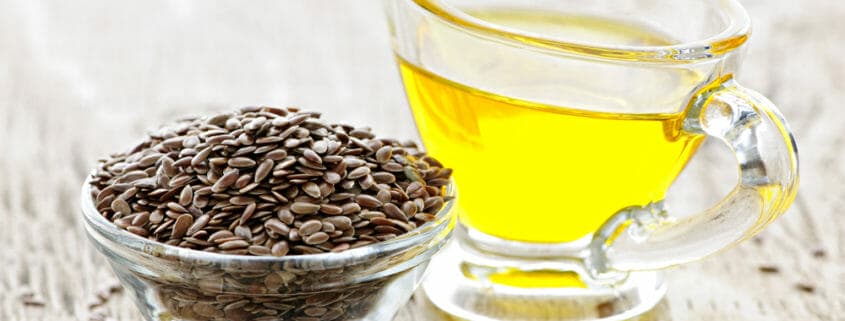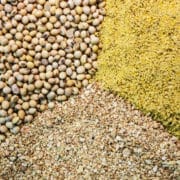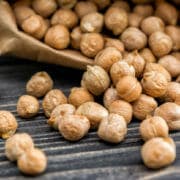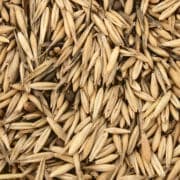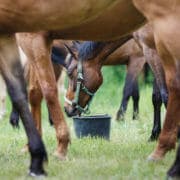Omega 3 for Horses: What, Why, How?
What is Omega 3?
‘Omega 3’ is a term used to describe a group of fatty acids that cannot be made by an animal. They are therefore classified as essential fatty acids because they must be consumed in the diet. There are three ‘Omega 3’ fatty acids; the ‘short chain’ alpha-linolenic acid (derived from plants) and the ‘long chain’ eicosapentaenoic acid (EPA) and docohexaenoic acid (DHA) (available almost exclusively from oily fish). Alpha-linolenic acid is the only form of Omega 3 present in a horse’s natural diet. This form of Omega 3 can be transformed (elongated) into EPA and DHA via a metabolic pathway in the horse’s body. EPA and DHA are the two biologically active forms of Omega 3.
What does Omega 3 do?
Omega 3 fatty acids are important constituents of all cell membranes. They are primarily needed for the production of eicosanoids, including leukotrienes (involved in inflammatory responses), prostaglandins (involved in smooth muscle contraction and inflammation), and thromboxanes (involved in blood clot formation). All cells in a horse’s body except the blood cells produce eicosanoids and the eicosanoids have their effect directly on the cell that produced them. They are highly potent chemicals and absolutely essential for the normal functioning of a cell.
Omega 3 fatty acids are also important in maintaining cell membrane structure and function as well as central nervous system development and immune function, plus they have a role in male fertility, affecting the shape, motility and concentration of sperm in seminal fluid.
Why is the Omega 6 to Omega 3 ratio important?
Omega 6 is another essential fatty acid. Omega 6 is present in equine diets as the ‘short chain’ linoleic acid (the plant form of Omega 6) which is then transformed (elongated) to the biologically active ‘long chain’ forms of Omega 6 known as dihomo-gamma-linolenic acid (DGLA) and arachidonic acid (AA). Both Omega 3 and Omega 6 are required in the equine diet. Omega 6, like Omega 3 is an important constituent of cell membranes and plays a critical role as a precursor for the eicosanoids (leukotrenes, prostaglandins and thromboxanes) that control swelling, inflammation, clotting and dilation.
The reason the Omega 6 to Omega 3 ratio is important is the plant derived Omega 3 fatty acids and Omega 6 fatty acids share a common enzyme in the first step of the metabolic pathway they need to travel to be ‘elongated’ into the long chain forms of Omega 3 and 6 fatty acids (which are then used to produce physiologically active prostaglandins).
Omega 3 fatty acids are first elongated to EPA and then EPA is turned into what are termed ‘series 3 prostaglandins’. Omega 6 fatty acids are elongated to DGLA which is then turned into ‘series 1 prostaglandins’ or AA which leads to the production of ‘series 2 prostaglandins’.
The first step in the elongation of Omega 3 and 6 fatty acids requires an enzyme called Delta-6 Desaturase (D6D). If there is too much Omega 6 present in the cells where prostaglandin production is occurring, the Omega 6 will ‘outcompete’ the Omega 3 fatty acids for this enzyme. The result being overproduction of the Omega 6 derived prostaglandins and not enough of the Omega 3 derived prostaglandins. The Omega 3 prostaglandins tend to have an opposing or modulating effect on the Omega 6 derived prostaglandins (Omega 3 derived prostaglandins aren’t necessarily anti-inflammatory, but they are less inflammatory than their Omega 6 relatives). The ultimate effect of too much Omega 6 in a diet is increased inflammation, increased risk of blood clotting and constriction of blood vessels.
Interestingly, phenylbutazone’s (Bute) mode of action is to block these same pathways, preventing Omega 6 fatty acids from being transformed into pro-inflammatory prostaglandins.
With the competitive nature between Omega 3 and Omega 6 and the consequences of a diet too high in Omega 6, the ratio of Omega 3 to Omega 6 in any animal’s diet (including our own) is extremely important.
Other nutrients including biotin, vitamin E, zinc, vitamin B12 and vitamin B6 are also reportedly required to allow the efficient transformation of alpha-linolenic acid to EPA and DHA.
What is the recommended Omega 6: 3 ratio in a horse’s diet?
To date there is no established ratio of Omega 6: Omega 3 in a horse’s diet. However, if we look at the diet horses evolved to eat, being primarily grasses and herbs, we can start to hypothesise that horses should have a diet that contains more Omega 3 than Omega 6. We suggest at the very most a horse’s diet should contain 1 part Omega 6 to 1 part Omega 3.
How much Omega 3 and Omega 6 are in common horse feeds?
Forages contain more Omega 3 than Omega 6 while grains contain more Omega 6 than Omega 3. Some oilseeds like sunflowers contain more than 200 times as much Omega 6 as Omega 3 while other oilseeds like linseed (flax) contain close to 3.5 times more Omega 3 than 6. A detailed breakdown of the amount of Omega 3 and 6 in common horse feeds is shown in the table below (data from Premier Nutrition).
| Ingredient Name | Omega 3 (%) | Omega 6 (%) | O6: O3 Ratio |
|---|---|---|---|
| Pasture (3.5% Crude Fat)* | 1.8 | 0.6 | 0.3: 1 |
| Grass Hay | 1.0 | 0.3 | 0.3: 1 |
| Alfalfa/Lucerne Hay | 0.5 | 0.4 | 0.7: 1 |
| Oats | 0.1 | 2.4 | 19.5: 1 |
| Corn/Maize | 0.03 | 1.9 | 55: 1 |
| Barley | 0.1 | 1.1 | 9.1: 1 |
| Rice Bran | 0.2 | 6.6 | 37: 1 |
| Wheat Bran | 0.2 | 2.1 | 11.6: 1 |
| Sunflower Seeds | 0.13 | 27.1 | 206: 1 |
| Full Fat Soybean | 1.4 | 9.8 | 7.2: 1 |
| Soybean Meal | 0.1 | 1.0 | 7.2: 1 |
| Lupins | 0.7 | 1.5 | 2: 1 |
| Faba Beans | 0.1 | 0.9 | 12.8: 1 |
| Copra Meal | 0 | 0.2 | N/A |
| Canola Meal | 1.1 | 2.2 | 2.0: 1 |
| Sugarbeet Pulp | 0.04 | 0.2 | 5.8: 1 |
| Soybean Hulls | 0.2 | 1.1 | 7.2: 1 |
| Brewers Grains | 0.2 | 2.2 | 9.3: 1 |
| Dried Distillers Grains (maize) | 0.1 | 3.8 | 55.4: 1 |
| Linseed (Flax) Whole | 19.1 | 5.6 | 0.3: 1 |
| Linseed Meal | 4.5 | 1.3 | 0.3: 1 |
| Coconut Oil | 0.1 | 2.0 | 20: 1 |
| Cod Liver Oil | 24.5 | 2.0 | 0.1: 1 |
| Canola Oil | 9.8 | 19.5 | 2: 1 |
| Soybean Oil | 7.2 | 51.7 | 7.2: 1 |
| Sunflower Oil | 0.3 | 60.5 | 206: 1 |
| Corn Oil | 0.9 | 55 | 55: 1 |
| Olive Oil | 0.7 | 10.8 | 15.7: 1 |
| Linseed (Flax) Oil | 57.4 | 13.9 | 0.24: 1 |
* Data from Mel’uchova et al (2008)
Diets primarily based on forages that don’t use large amounts of oils like corn or sunflower oil should contain more Omega 3 than Omega 6. Diets that contain a moderate to large amount of grain and small amounts of forage (like the typical racehorse diet) will almost certainly contain far more Omega 6 than Omega 3.
Is there research to support the use of Omega 3 fatty acids in horses?
Most of what we know about omega fatty acids is derived from research in other animal species including humans. There is however some equine research that does lend support to supplementing diets with Omega 3 fatty acids. In a study that used 16 horses with arthritis, Manhart et al (2009) reported that horses supplemented with DHA and EPA experienced a greater decrease in joint fluid white blood cell counts and lower plasma prostaglandin E2 levels (an Omega 6 derived prostaglandin which is a pro-inflammatory pain producer and plays a major role in osteo-arthritis. It is this prostaglandin that many non-steroidal anti-inflammatory drugs block the production of to reduce pain and inflammation).
A study published in the Canadian Journal of Veterinary Research in 2002 (O’Neill et al) looked at the ability of flaxseed to reduce the inflammation associated with culicoides (midge) hypersensitivity (sweet itch or Queensland itch). These researchers reported that feeding 1 lb of flaxseed per 1000 lb of bodyweight to horses (or 0.5 kg per 500 kg bodyweight, equivalent to 3.5 oz or 100 ml of flaxseed oil) over a period of 42 days reduced inflammation and the size of the area that reacted to culicoides extract which was injected into the skin. In contrast to this study however, Friberg et al (2002) reported that horses supplemented with either 200 ml/day of flaxseed oil or 200 ml/day of corn oil showed no difference in the lesional surface area associated with culicoides allergy or the number of times horses itched. O’Neill et al believe the difference between the results reported by these two studies may lie somewhere in the fact they used whole flaxseed and not just the extracted oil. Unfortunately, the omega 6 to omega 3 ratio was not reported in these studies. Horses in the Friberg et al study were maintained on ‘pellets’ so it is possible that their dietary Omega 6 ratio was too high for 200 ml of flax oil to have a noticeable benefit. It was noted in this study that a miniature horse receiving the full 200 ml dose responded particularly well to the supplement which may indicate that the dose for the larger horses needed to be much higher to have a significant benefit.
Brinsko et al (2009) studied the sperm quality in 8 stallions when they were fed their normal diets with or without a DHA-enriched supplement. This study found no difference in fresh sperm quality, however, as the semen was cooled and stored, sperm quality tended to be better when the stallions were supplemented with DHA. Most of the improvements observed however were not statistically significant (which means they may have just happened by chance and may not actually be due to the supplement).
Pagan et al (2010) reported that supplementation with 60 ml of fish oil significantly increased serum and red blood cell EPA and DHA while supplementation with 60 ml of corn oil significantly reduced red blood cell EPA levels. Pagan et al (2012) have also reported improved insulin sensitivity in horses supplemented with omega 3 fatty acids from fish oil.
When should you supplement?
If your horse’s diet contains a moderate to large amount of grain or high Omega 6 oils like corn or sunflower oil you may need to consider adding additional Omega 3 to the diet to keep the ratio of Omega 6 to Omega 3 at or preferably below 1: 1. Take the following diets as examples:
Diet 1 – High in Omega 3
| 10 kg/day (22 lb) | Pasture |
| 2 kg/day (4.4 lb) | Alfalfa/Lucerne Hay |
| 0.5 kg/day (1.1 lb) | Oats |
| 200 g/day (7 oz) | Sunflowers |
| 100 g/day (3.5 oz) | Vitamin and Mineral Supplement |
This diet will contain an Omega 6 to Omega 3 ratio of 0.4: 1 and does not need additional Omega 3 supplementation. The diet is however still higher in Omega 6 than a 100% forage based diet so some Omega 3 supplementation may be warranted in certain situations, for example if the horse is arthritic.
Diet 2 – High in Omega 6
| 2 kg/day (4.4 lb) | Pasture |
| 4 kg/day (8.8 lb) | Alfalfa/Lucerne Hay |
| 3 kg/day (6.6 lb) | Oats |
| 2.5 kg/day (5.5 lb) | Corn/Maize |
| 250 g/day (9 oz) (5.5 lb) | Sunflowers |
| 250 ml/day (9 floz) | Corn Oil |
| 100 g/day (3.5 oz) | Vitamin and Mineral Supplement |
This diet will contain an Omega 6 to Omega 3 ratio of 3.5: 1 and would benefit from additional Omega 3 supplementation. Adding 400 ml of linseed oil to this diet will lower the Omega 6 to Omega 3 ratio to 1: 1 and also allow for some of the high Omega 6 grain to be removed from the diet. You can monitor your Omega 3 and 6 levels and the ratio in FeedXL Premium and Advisor plans. Note however that most manufacturers do not yet include this information when reporting the nutrients in their products!
How should you supplement?
There are various ways to add additional Omega 3 to diets. The best-known Omega 3 supplement for horses is linseed (flax) oil. Linseed oil is 57% Omega 3, making it a useful Omega 3 supplement. Freshly ground linseed can also be used (read FeedXL Newsletter # 22 Feeding Flaxseed). Linseed meal will have very little effect on a diet’s overall Omega 6 to 3 ratio as even though linseed meal does contain more Omega 3 than 6, the amount of Omega 3 in linseed meal is so small it really won’t influence the overall diet’s Omega fatty acid ratio. Commercial Omega fatty acid supplements are also available and these now often contain fish oil to provide a direct source of DHA and EPA in the diet.
Of course, the best way to maintain a balanced Omega 6 to 3 ratio in your horse’s diet is to maintain them on a largely forage based diet and only use grains and oilseeds like sunflower seeds in moderate to large amounts where absolutely necessary.
Take home messages
- Diets that contain a lot of grain or high Omega 6 oils like corn or sunflower oil may cause your horse’s diet to contain more Omega 6 than Omega 3 fatty acids.
- Too much Omega 6 in a horse’s diet interferes with the body’s use of Omega 3 fatty acids. This imbalance could lead to excess inflammation and problems like arthritis.
- To help modify the inflammatory reaction of a horse’s body to stimuli like exercise, the Omega 3 to 6 ratio needs to be kept in balance.
- Omega 6 is just as important in the diet as Omega 3, they just need to be kept in balance with one another.
- There is no established ratio of Omega 6 to Omega 3 for horses, however a horse’s natural diet contains more Omega 3 than Omega 6, so keeping your horse’s diet ratio at 1: 1 or less is logically what will be best.
Do you have a question or comment? Do you need help with feeding?
We would love to welcome you to our FeedXL Horse Nutrition Facebook Group. Ask questions and have them answered by our qualified equine nutritionists and spend time with like-minded horse owners. It’s free!
Click here to join the FeedXL Horse Nutrition Facebook Group

